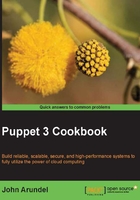
Using community Puppet style
If other people need to read or maintain your manifests, or if you want to share code with the community, it's a good idea to follow the existing style conventions as closely as possible. These govern such aspects of your code as layout, spacing, quoting, alignment, and variable references, and the official Puppet Labs recommendations on style are available at
http://docs.puppetlabs.com/guides/style_guide
How to do it…
In this section I'll show you a few of the more important examples and how to make sure that your code is style-compliant.
Indent your manifests using two spaces (not tabs), as follows:
node 'monitoring' inherits 'server' {
include icinga::server
include repo::apt
}
Always quote your resource names, for example:
package { 'exim4':
Not
package { exim4:
Use single quotes for all strings, except when:
- The string contains variable references (for example,
${name}) - The string contains character escape sequences (for example,
\n)
In these cases you should use double quotes. Puppet doesn't process variable references or escape sequences unless they're inside double quotes.
Always quote parameter values that are not reserved words in Puppet. For example, the following values are not reserved words:
name => 'Nucky Thompson', mode => '0700', owner => 'deploy',
But these values are reserved words and therefore not quoted:
ensure => installed, enable => true, ensure => running,
Always include curly braces ({}) around variable names when referring to them in strings, for example:
source => "puppet:///modules/webserver/${brand}.conf",
Otherwise Puppet's parser has to guess which characters should be a part of the variable name and which belong to the surrounding string. Curly braces make it explicit.
Always end lines that declare parameters with a comma, even if it is the last parameter:
service { 'memcached':
ensure => running,
enable => true,
}
This is allowed by Puppet, and makes it easier if you want to add parameters later, or re-order the existing parameters.
When declaring a resource with a single parameter, make the declaration all on one line and with no trailing comma:
package { 'puppet': ensure => installed }
Where there is more than one parameter, give each parameter its own line:
package { 'rake':
ensure => installed,
provider => gem,
require => Package['rubygems'],
}
To make the code easier to read, line up the parameter arrows in line with the longest parameter, as follows:
file { "/var/www/${app}/shared/config/rvmrc":
owner => 'deploy',
group => 'deploy',
content => template('rails/rvmrc.erb'),
require => File["/var/www/${app}/shared/config"],
}
The arrows should be aligned per resource, but not across the whole file, otherwise it can make it difficult for you to cut and paste code from one file to another.
There's more…
When several people are working on a codebase, it's easy for style inconsistencies to creep in. Fortunately, there's a tool available which can automatically check your code for compliance with the style guide: puppet-lint. We'll see how to use this in the next section.